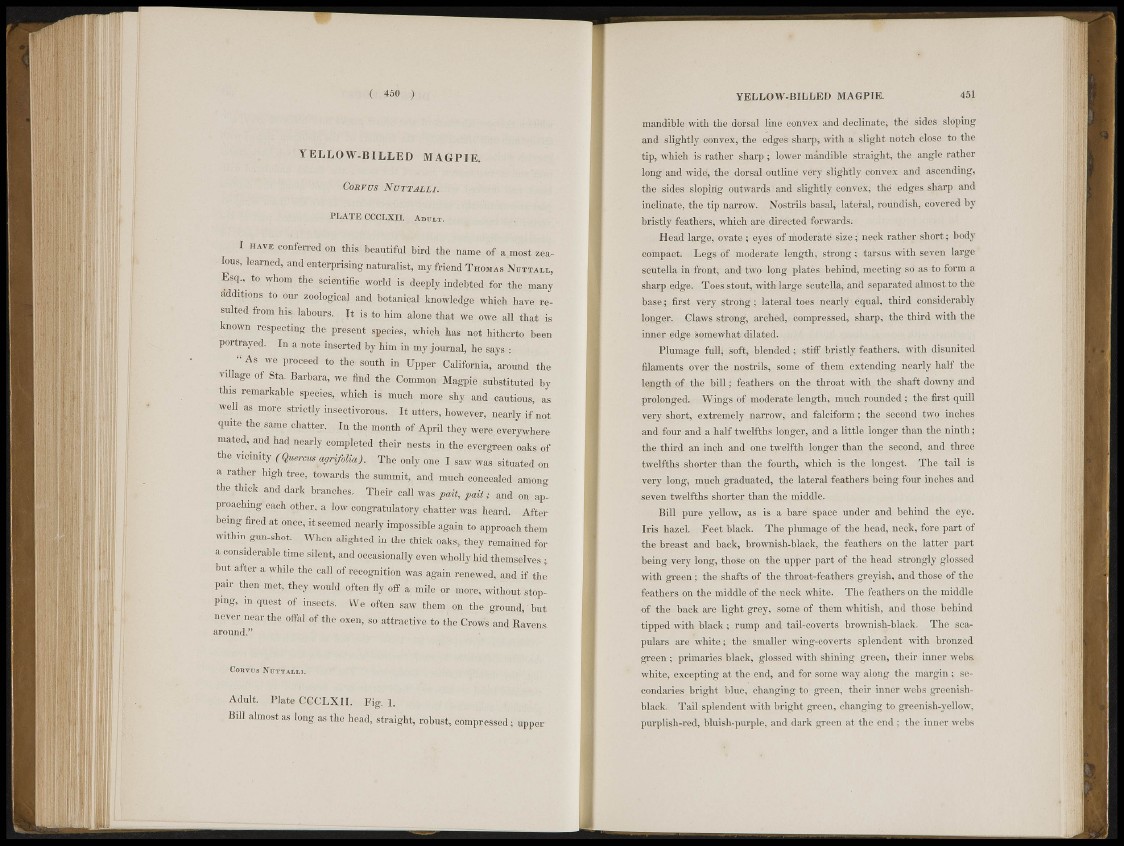
( 450 )•
Y E L L O W - B I L L E D MAGPIE.
Courus NiUTTALLI.
1'IUW'K mjl.XII. AD U L T .
I HAVE c'oriionn«l on this beautiful bird FTG-JSMRF amostzea-
•• fo'IS, loan,o,l, and enterprising naturalist, my friend T H O M A S N D T T A M ,
Esq., ,to yhom tho .^¡Mntilu- world is <lupjdy jndel>t^ ^or.^,,. many
additions to our zoological and botanical knowledge. which have resulted
from hi^IakourA. ft is to him alope that we owe all that .fes
known respecting the present sggcies, which has not hitherto been
portrayed. In a note msertod by him in my journal, lie sa.ys *
"As we proceed to- the, south in Upper California, around the
village of Sta. Barbara, we find the Common Magpie substituted by
this remarkable species,, which is much more shy and cautious, as.
well as more striptly insectivorous. It utters, however, nearly if not
quite the sanm chatter,.. I n the month of April they-were everywhere
mated, and had nearly 'gWpleted their nests in the evergieen oaks ,/f
the vicinity (Qwrcm agrifolm)., The only one I saw was situated on
a rather high tree, towards tli« summit,, and much concealed »mong
the thick and dark branches Their call was pmt, pent; and en approaching*
eaeh other, a low congratulatory chatter was heard. Afterbeing
fired at once, it,seemed nearly impossible again to approach them
within gun-sho% When alighted in the thifek oaks, they remained for
a considerable time sHSnt, and occasionally earen wholly hid themselves •
but after a while the call of recognition was again renewed, and'if the'
pair then met, they wfould,often fly off aj m i f e o r more, without stopping,
m ques f t f insects We often saw them-on the ground, hut
novo,- near the oflaJ of tlm oxen, so attractive to the Crows and Havens,
around."
Coiivus NSrTTALr.r.
Adult. I'lato GKCI.XII. 1 % 1.
Bill almost as long.as the head, straight, robust, compressed: upper
YELLOW-BILDED MAGPIE. 451
mandible with the dorsal lifiie convex and declinate; the sides sloping
and Slightly convex, the edges sharp, with a slight notch close to the
tip, which is rather sharp : lower mandible straight, the angle rather
long'and Wide, the dorsal outline' very .¡Sightly convex and ascending,
the sides slopiiig outwards'and slightly convex; t.lie edges sharp and
inclinate, the tip narrow. Nostrils basal; lateral, roiindish, covered by
bristly feathers, which are directed forwards:
Head large, ovate if eyes of moderate size;' neck rather short; body
compact. .'I.egsoi' moderate length, strong: tarsus with seven large
scutella in front; and two; long plates behind, meeting so as to form a
sharp edge. Toes stout, with large scutella, and separated almost to the
base ;, first vtay. strong .^lateral toes nearly ¿qual, third considerably
longer, ('laws strong, arched, compressed, sharp, the third with the
inner edge: somewhat dilated:
Plumage foil; soft, blended ; stiffi ibristlf feathers, with disunited
filaments over the nostrils, some of them extending nearly half the
lepgth of the bill; feathers on the throat with the shaft downy and
prolonged. Wings of moderate length, much rounded; the first,qi]tiUj!
very short, extremely narrow,, and falciform; the second two inches
and four and a half twelfths longer,; and a little longer than the ninth;
the third an inch and one twelfth longer than the. second, and three
twelfths shorter than the fourth, which is the longest. The tail is
very long, much graduated, the lateral feathers being four inches and
•seven twelfths shorter than the middle.
Bill pure yellow, as is a. bare space under and behind the eye.
Iris hazel. Feet black. The plumage of the head, neck, fore part of
the breast and back, brownish-black, the feathers on the latter part
being very longs those on the upper part of the head strongly glossed
with green; the shafts of the throat-feathers greyish, and those of the
feathers on the middle of the neck white. The feathers on the middle
of the back are light grey, some of them whitish, and those behind
tipped with black; rump and tail-coverts brownish-black. The scar
pulars are white; the smaller wing coverts splendent with bronzed
green ; primaries black, glossed with shining green, their inner webs
white, excepting at the end, and for some way along the margin ; secondaries
bright blue, changing to green, their inner webs greenishblack.
Tail splendent with bright green, changing to greenish-yellow,
purplish-red, bluish-purple, and dark green at the end; the inner webs